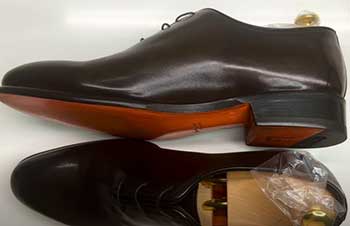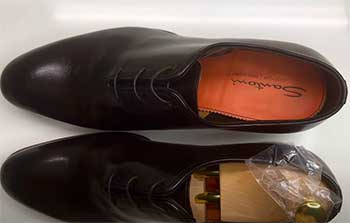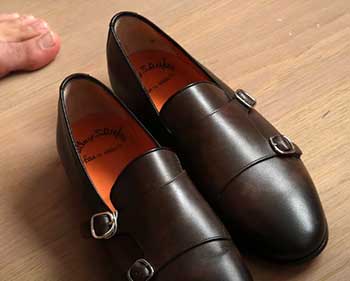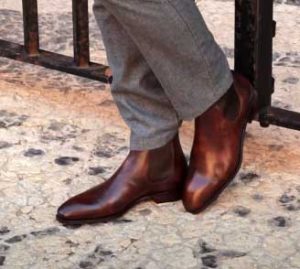As an avid shoe enthusiast, I’m always on the lookout for high-quality footwear brands that offer both style and comfort. Recently, I decided to try out a pair of shoes from Santoni, an Italian luxury brand known for their meticulous craftsmanship and elegant silhouettes.
After wearing my Santoni oxfords for several months now, I’ve come to appreciate both the positives and negatives of owning a pair of these luxurious kicks.
In this review, I’ll break down my experience with Santoni shoes, including the key features, comfort, and sizing, so you can determine if they are worth the steep price tag.
Overview of Santoni Shoes

Founded in 1975 and headquartered in Corridonia, Italy, Santoni pioneered the concept of “shoe engineering,” emphasizing technical innovation in shoe construction.
Using cutting edge techniques like plastic molded heels and vulcanized rubber soles, Santoni aims to make the most anatomically comfortable high-end shoes possible.
In addition to comfort, Santoni is renowned for their minimalist, sleek styles often featuring patent leather, suede, and other premium materials.
Their shoes are always impeccably crafted by hand in their Italian facilities. Each pair takes a remarkable 8-10 hours to make and goes through 100 individual steps from start to finish.
While Santoni offers a full range of dress shoes, boots, sneakers, and other footwear for both men and women, they are undoubtedly most famous for their exquisite double monk strap shoes for men. Their shoes generally retail between $500-1000 USD, firmly placing them in the luxury echelon.
Below are some of the key features and technologies Santoni employs in their shoe making:
- Patented Memory Foam Insole – contours to your foot’s shape for customized comfort
- Blake Rapid Construction – flexible stitching for enhanced pliability
- Vibram Outsoles – durable, shock absorbing rubber soles
- Water Resistant Leathers – hydrophobic materials prevent stains
- Hand Lasting – shoes molded on a physical last for ideal anatomical fit
- Goodyear Welted Soles – allows resoling for greater longevity
By combining these technical innovations with impeccable Italian craftsmanship, Santoni aims to produce what they describe as “noble shoes” for the discerning gentleman. But are these details worth the hefty cost? Let’s take a deeper look at my first-hand experience.
Also Read: Differences Between TLB Mallorca And Carmina Shoes.
Unboxing and Initial Impressions

After excitedly unboxing my pair of Santoni double monk strap oxfords in black calfskin leather, I was impressed by the elegant presentation.
Each shoe came individually wrapped in sleek black tissue paper and neatly arranged in the signature Santoni silver box.
Immediately apparent was the incredible quality of materials. The supple calfskin leather felt sturdy yet flexible.
Brushing my fingers over the leather, I could detect no flaws or stitches out of place. The leather lining inside felt smooth and comfortable.
Trying the shoes on, they slid effortlessly onto my feet, enveloping them in luxurious softness. The Memory Foam insole provided instant cushioning.
Walking around my house to break them in, I noticed how the lightweight Blake construction gave them a flexibility not often found in dress shoes. The leather soles also offered a nice grip.
Overall, the initial unboxing and wear impressed me with Santoni’s attention to detail and craftwork. Each material and design element seemed carefully considered for both visual appeal and comfort.
Santoni Shoe Sizing and Fit
One crucial aspect of any shoe is finding the right size and fit. With Santoni’s handcrafted Italian construction, the sizing follows similar conventions as other high-end European shoes.
I found Santoni shoes run quite true-to-size, but err slightly on the narrow side. For best fit, I’d recommend ordering your standard US size unless you have wide feet, in which case sizing up by half or going up a width would be wise.
Some key factors about the fit:
- Snug heel and midfoot for support
- Tapered, almond toe shape fits most foot types
- Leather lining molds comfortably to your foot
- Memory foam insole offers customized cushioning
- Lightweight yet durable leather sole construction
Overall, the last used by Santoni results in a slimmer, elegant silhouette made to mold to your foot’s contours. While not the widest fitting, for standard or narrower feet, Santoni provides an ideal sleek shape.
Evaluating Santoni Shoe Comfort
Perhaps the most important quality in a high-end dress shoe is all day comfort. Despite their fashionable look, Santoni shoes are engineered for comfort. Here’s how they perform in key areas:

- Cushioning – The layer of memory foam lining the leather insole provides noticeable cushioning and shock absorption, especially helpful for hard surfaces like concrete. My feet felt pampered yet supported.
- Flexibility – The Blake construction gives Santoni shoes a nice flexible feel in the forefoot when walking. The upper moves naturally with the foot without any pinching or restrictions.
- Breathability – The calfskin leather, while sturdy, remains fairly breathable. My feet never became overly sweaty when wearing these shoes for long days.
- Break-In Period – As with most high quality leather shoes, some minor break-in is required to soften the materials and perfect the fit. But Santoni’s construction techniques minimize this. Within 3-4 wears my shoes were broken in.
- Support – My Santoni shoes provide excellent arch support, enhanced by the molded leather insole and memory foam. And the snug heel cup keeps my foot securely in place.
So in summary, the comfort level of my Santonis has impressed me for such a stylish shoe. The technical innovations used in their construction really make a difference versus cheaper leather shoes. While not necessarily sneaker-like comfort, they remain pleasant to walk in for hours at a time.
Also Read: Comparison of Loake And Meermin Shoes.
Santoni Shoe Styling – From Classic to Contemporary
Santoni is beloved by shoe aficionados not just for comfort but also for their timeless Italian styling. Their minimalist silhouettes in sleek leathers pair perfectly with everything from tailored suits to casual chinos.
Here are some styling tips:
- With Suits – The low profile double monk strap model I own works well with modern tailored suits. The sleek almond toe shape complements lapel shapes nicely. Stick to black or dark brown for versatility.
- Business Casual – For slacks or chinos, brown Santoni loafers or ankle boots add an elevated polish. Get creative mixing leather textures like suede and patent.
- Jeans & Leather – Santoni’s sleek chelsea boots look sophisticated yet edgy with dark denim and leather jacket. A versatile combo for dates or everyday wear.
- Monochromatic – Go full monochrome with black or tan loafers matched to pants in the same shade. This elongates the leg for a streamlined silhouette.
- Weekend Wear – More casual Santoni sneakers in leather and suede pair well with casual button downs or polos. Choose fun colors to add flair.
While Santoni offers modern takes on classics, their shoes work across eras. The minimalist craftmanship provides flexibility for everything from a Rat Pack inspired ensemble to men’s contemporary fashion.
Santoni Shoe Care & Maintenance
Investing in luxury shoes like Santoni’s requires dedication to proper care and maintenance. Here are some tips for making your shoes last:
- Use shoe trees to absorb moisture and maintain shape when not wearing
- Brush with horsehair brush before and after each wear to remove dust
- Clean leather with leather cream polish every few months
- Apply waterproofing spray to protect against rain and stains
- Resole through a cobbler when outsoles become worn down
- Store in breathable shoe bags away from direct sunlight
- Allow leather to rest 48 hours between each wear for longevity
As genuine Italian leather shoes with Goodyear welted soles, Santonis are built to last decades with proper upkeep. Take time to care for them and they’ll continue looking pristine while remaining comfortable.
Are Santoni Shoes Worth the Cost?
After evaluating my Santoni shoes across all these factors – materials, construction, comfort, style, and longevity – are they worth an average price of $600-1000? In my opinion, the answer is yes, if luxurious Italian craftsmanship is important to you.
Here’s why I believe the investment is justified:
- Peerless Construction – Every stitch and detail executed flawlessly. You can feel the handmade quality.
- All Day Comfort – Innovations like memory foam make even stylish shoes comfortable.
- Timeless Styling – Santoni’s minimalist silhouettes remain fashionable for years.
- Quality Materials – From premium leathers to molded soles, only the best components used.
- Life-Long Durability – Proper care allows Santonis to last decades.
- Heritage Brand – Santoni has reputation for high standards since 1975.
Certainly $500+ is not affordable for everyone. Lower cost shoes can also have nice looking leather. However, they pale in comparison when it comes to technical comfort features, meticulous craftsmanship, and durability.
For those who can splurge on a pair of handmade Italian Santonis, you get what you pay for in spades. The comfort, styling, and longevity justifies the price for high quality footwear. Not shoes I’d wear every day, but Santonis make excellent additions for elevating any wardrobe.
Also Read: Why Should You Get Lottusse Shoes?
Santoni Shoes: FAQ
Here are answers to some frequently asked questions about Santoni shoes:
Yes, Santoni is considered a luxury shoe brand based on their premium materials, quality construction, Italian heritage, and higher pricing averaging $500-1000 per pair. They compete with other high-end shoes from brands like John Lobb, Crockett & Jones, and Berluti.
Some high-quality shoe brands include Allen Edmonds, Alden, Crockett & Jones, Gravati, and Santoni. Key indicators are use of fine leathers, sturdy stitching and soles, and hand crafted construction. Made in Italy, England, Spain, or Portugal.
Santoni, John Lobb, and Crockett & Jones consistently rate among the top men’s shoe brands for quality. Berluti and Edward Green also excel at craftsmanship. But quality comes at a price – expect to pay $500+ for shoes built to last.
Santoni shoes are handmade in company owned workshops located in Corridonia, Italy. This city in the Marche region has a tradition of shoemaking dating back to 1975 when Santoni was founded there.
Final Verdict: Santoni Shoes Are Worth the Splurge
To summarize my experience after wearing Santoni shoes for several months, I firmly believe they live up to their reputation for high end luxury quality and make a worthwhile investment if you value Italian craft.
While the price tag of $500-1000 is steep, every meticulous detail in their construction, buttery comfort, and timeless silhouette justifies the cost for me. The difference from cheaper shoes or mass production is obvious in the quality.
That said, Santoni shoes may not suit all budgets or needs. For maximum versatility, I’d suggest starting with a pair of black or brown oxfords or loafers. Or for more adventurous styles, their suede boots or monk straps add flair.
If the price still seems hard to swallow, try finding a lightly used pair on eBay for a discount. Well cared for Santonis resole beautifully.
At the end of the day, few brands rival the luxury and meticulous old world craftsmanship of Santoni’s Italian shoes. If that appeals to you, then Santoni is undoubtedly worth the investment. Just be sure to care for them properly and they’ll deliver lasting comfort and sophisticated style for decades to come.



